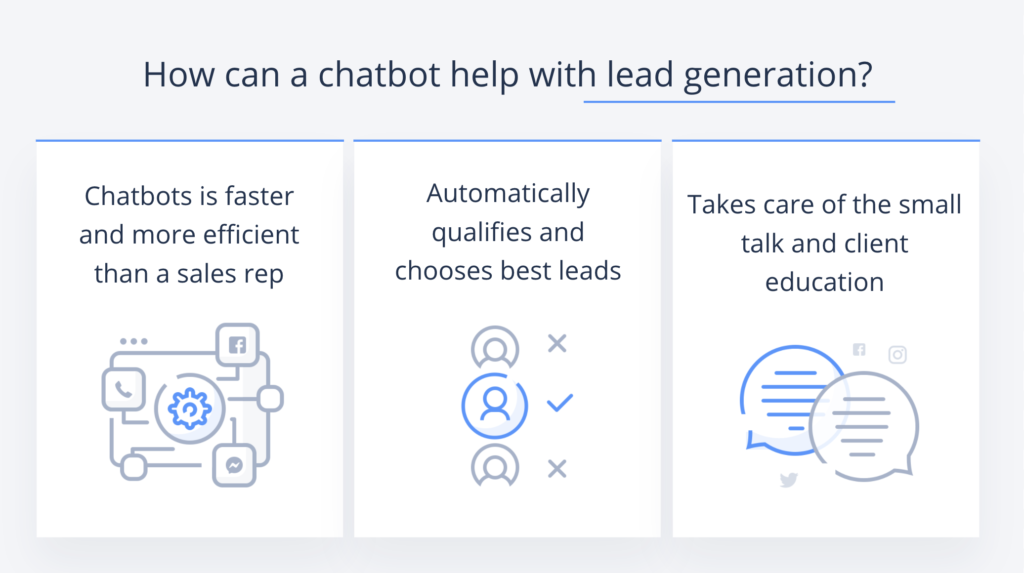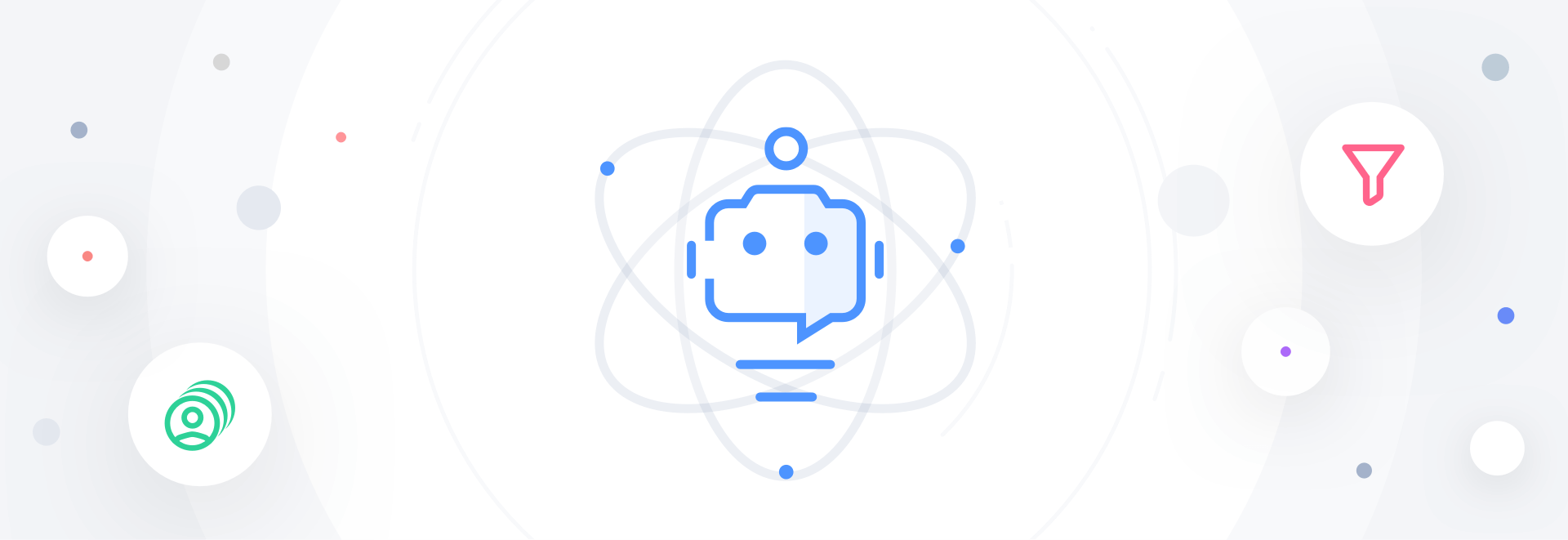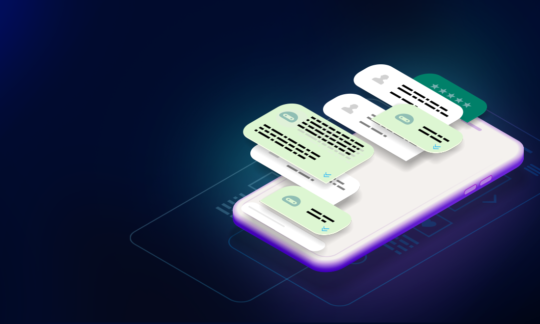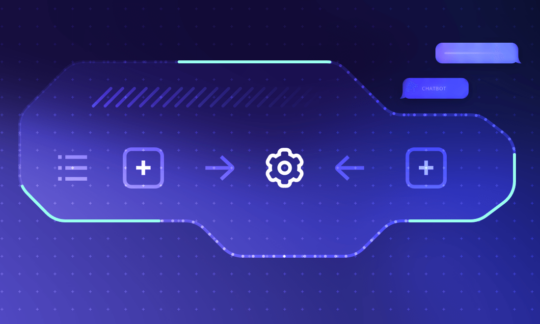Chatbots and lead generation – a match made in heaven
We keep talking about how great chatbots are for marketing and customer service purposes – but they can be so much more! As with any emerging technology, a ton of people have tried to apply it to many different areas of business. While chatbots didn’t turn out to be a great hit in, say, human resources, they keep finding new successes in truly unexpected areas. For instance, did you know chatbots are really good for lead generation?
We know – we wouldn’t have thought of it at first, too. The more you think about it, however, the more it makes sense. Messaging apps are all the rage! Billions of people use at least one messaging app, with the market leader – WhatsApp – clocking in at an even two billion users worldwide. These people are also very likely to get in touch with brands through messaging apps. This led to a widespread adoption of social customer service, as well as chatbots.
What this essentially boils down to is simple – if you’re a modern brand, you’re already using chatbots as an essential part of your customer service experience. Why not put them to work in the sales process as well?
By plugging in chatbots at the beginning of the customer funnel you can drastically reduce time of the lead generation process. Bots can easily qualify leads, answer pre-sales questions and assist prospective customers in filling the form! Moreover, by analysing chats with your users, you can easily identify and target potential sales leads on a massive scale.
What even is lead generation, anyway?
Let’s back up a bit and make sure everyone’s up to speed. In simple terms, lead generation is the process of identifying potential customers and collecting their contact data. The sales team uses that information to present offers and deals. Lead generation lets you reach potential customers early in their buyer’s journey, so you can earn their trust, build a relationship, and be by their side until they’re ready to make a purchase.
Obviously, a solid lead generation strategy is what companies live and die by. Because customers spend so much time online, developing a strong digital presence is a key part of lead and pipeline generation. This is best achieved through inbound marketing strategies like content marketing, website forms, and search engine optimization — all of which work together to drive prospective customers to your website. Here are the basic steps of digital lead generation:
- The customer discovers your website or otherwise comes in contact with your brand
- After engaging with a call to action (for example ‘book a meeting’), they are taken to a landing page
- The landing page solicits contact information
- The brand sends an offer to the customer – at which point they become a lead
According to a study by Salesforce, B2B sales reps spend 21% of their time doing lead gathering. That is about 2.5 months in a working year. No wonder companies around the world look for a solution to increase efficiency in their sales processes. An intelligent lead generation chatbot could eliminate this time wastage as it can score and qualify leads to show you the most important leads to follow up.
How can a chatbot help with lead generation?
1. Gauge initial interest from a customer
Let’s try and puzzle out how we can introduce chatbots to the process. The first step is easy – the customer contacts your brand on social media or a messaging app. You can have your chatbot gauge their interest in a given offer related to their query. For instance, if the customer requests information about a product of yours, the bot can ask whether or not they’d like a special offer – at which point they can give the bot the relevant contact details.
2. Answer questions, explain product or offering
The chatbot can also assist in pre-sales queries, for example explaining the warranty policy, payment methods or shopping options. In less than a minute a customer is served and their questions are answered! It is crucial to earn customer trust at this initial stage of the sales process, as that is the moment when customers make up their mind and decide on final purchase.
3. Qualify leads and add them to the CRM
During its chat with the customer, the bot can also answer additional questions regarding your offers (for example,’how do I qualify for a discount?’). Using that information, you can automatically take care of gauging the value of any potential lead. Because of that, only the most valuable leads get added to your CRM database – saving you the time on soliciting customers that aren’t likely to commit to a purchase.
4. Collect contact details
Once the customer did their research and gathered all important information they will be able to proceed to the next step – providing their contact details. In the digital world it’s usually done by filling out lengthy online forms on a dedicated landing page. Not so with chatbots – they can ask a few questions in a natural, friendly way and add the relevant information to your CRM solution.
5. Schedule a meeting
What is more, chatbots can also book a meeting as soon as the customer expresses their interest. The technology allows bot to pull information from sales reps’ calendars, find available slots and offer them to the prospective customer. Another option is to integrate your chatbot with third party calendar apps such as Calendly in order to show the available time slots, allowing the customer to pick a date that works best for them.
5. Collect leads when your sales team is offline
Your website is not offline when you are – and neither is your lead generation strategy. People may research your products and services outside of your working hours – and you do not want to miss out on those potential customers! Since chatbots are available 24/7/365, they can take care of every potential prospect – no matter when they decide to manifest. Your sales reps will begin each work day with a new list of leads to contact.

In summary? In a couple of minutes, the chatbot was able to gauge initial interest of a prospective customer, answer their burning questions, collect their contact data, save them as leads in your CRM tool and book a meeting with a sales rep! Everything in a hassle-free, easy and non-intrusive way, with no interaction from the sales department.
Of course, that’s just the basics. Consider the advantages of chatbots to see their full potential in lead generation:
Why are chatbots a good lead generation tool?
- 24/7/365 availability across multiple different channels
- Friendlier than a boring contact form
- Automatic lead evaluation
- Able to provide additional information on-demand
What’s more, chatbots enjoy a good reputation among customers, especially millennials and gen Z. That’s not surprising – those people grew up immersed in technology and are used to receiving instant results. Chatbots are a natural fit for that demographic.
Sales bots are successful as they put 100% of focus on the client and their needs. They are constantly available and never leave anybody without an answer. The customers’ problems are instantly resolved and their enquiries are immediately taken care of. Modern technology and conversational AI allows companies to maximize their revenue and become fully customer-centric.
What does a lead generation chatbot look like in action?
If you’re still unsure as to how a chatbot can tie into your overall lead generation strategy, just take a look at this video. It shows a simulated conversation between a customer and a SentiOne chatbot.
How to prepare a chatbot for lead generation?
Creating a lead generation chatbot isn’t much different from creating a chatbot for any other purpose. As such, the process is very similar – and it can be applied to both new and existing chatbots.
Here’s how to prepare a chatbot for lead generation:
- Gather your data. Historical conversations from Messenger, WhatsApp, LinkedIn Messages and transcripts from sales conversations will be helpful in shaping your chatbot. You’re looking for repeating patterns – your chatbot will be built around answering commonly asked questions. Segment your data into different categories: pre-sales questions, product questions, process questions, price quote, availability questions, booking a meeting, etc.
- Prepare a relevant training dataset based on your data. Ensure that you have a very wide, very diverse set of variations for each question to make sure the bot becomes as accurate as possible.
- Select the KPIs which will decide the success of your chatbot. For lead generation chatbot we would recommend a mix of the following: number of answered questions, number of resolved cases outside working hours, number of cases redirected to a sales rep, booked meetings, number of leads added to the CRM tool.
- Spend some time fine-tuning your natural language understanding (NLU) engine. Make sure your bot is able to recognise various keywords and phrases used within your niche, as well as any odd questions which may pop up from time to time. Teaching the bot to recognise more than just patterns can further improve your intent detection accuracy and vastly improve your users’ experience with the bot.
My chatbot is ready – what next?
Like we said before, chatbots have enormous potential in many different areas – especially marketing and customer service. We have written a massive guide to chatbots and their many uses, if you’d like to learn more.
Of course, chatbots are just one part of the wonderful world of automation. And wouldn’t you know it? We wrote an easy-to-digest guide to automating your customer service department, too!
Our flagship product, SentiOne is a one-stop-shop for social listening, customer service automation, and chatbot creation and deployment. If you haven’t yet started optimising your online processes, get in touch with us.



